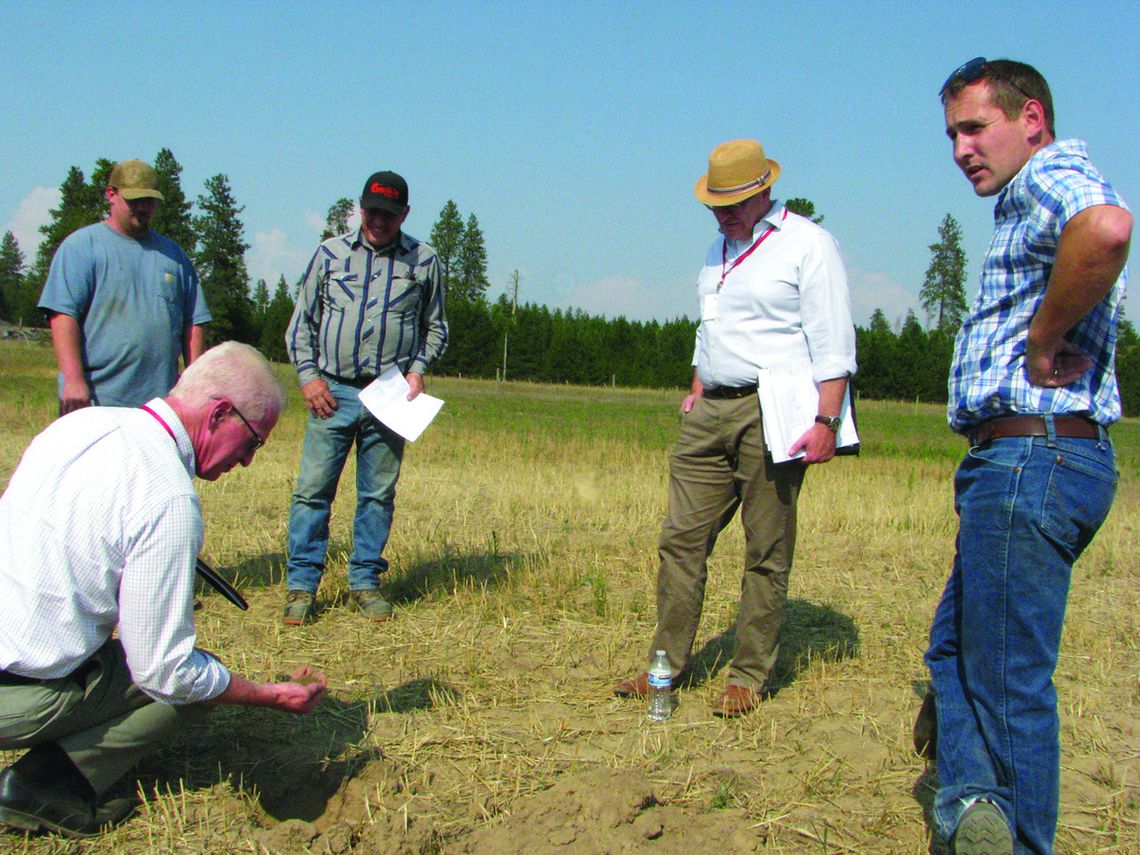DIAMOND LAKE – A years’ long drought, rising fuel, and flat hay prices have made it difficult for hay farmers to make a profit in Pend Oreille County.
Washington State Hay Growers Association Vice President Jon Paul Driver organized a meeting of some hay growers to meet with Steve Bruchman and Andrew Rolwes of U.S. Rep. Michael Baumgartner’s office to call attention to how the drought and other things are impacting farmers. Bruchman and Rowles mostly listened.
Pend Oreille County was 90 days without rain the first week of September, Driver said.
Farmers buy federal crop insurance, but because there is no weather station on Pend Oreille County, it is difficult to document the true extent of drought. Having documented drought is what causes the insurance to take effect.
Rainfall to establish drought is only measured at weather stations and airports and there is no airport, other than the Ione airport in the north county.
“We don’t have a weather station,” Driver said. The closest is in Deer Park, about 20 miles away. “I mean, we just have no representation for our weather data.”
The Pasture, Rangeland and Forage Insurance, the only insurance that applies to hay producers and drought, is dependent on a rainfall index.
Just when measured rainfall occurs makes a difference, Driver said. He added that in 2023 he had lost his entire growing season and paid insurance premiums all year. He raises hay on 800 acres spread out over 35 miles.
“We hit the last day in August, and we got a big rainstorm and instead of a $25,000 payment, I got a $1,200 payment,” he said. A more realistic measurement of the true drought conditions would help farmers, he said.
It’s been years since many hay producers have netted much profit, producers told Bruchman and Rowles from Baumgartner’s office.
“2020 was the last year we made money,” James Cummins of Whitepine-Flats Farms of Elk said. “We went from the best year ever to the worst year and we haven’t recovered since then. We’re still trying to get crops established because of that drought and haven’t got the moisture back from the normal level.”
Cummins said it rained at the right time in 2020, so farmers made money even though hay prices were down.
“We were selling hay for less than $200 a ton, fertilizer was down, fuel was less than $2 a gallon and we were making more money than now,” Cummins said.
Hay prices rose in 2021, Cummins said. He grows hay on 1,100 acres, some in Spokane County and most in Pend Oreille County.
“We started charging $350 a ton for hay in 2021 because it was a drought year,” he said. “Today I still sell you the same field of hay for $350 a ton because I can’t get any more.”
Yet the price of the things needed to grow hay, the fertilizer, fuel and interest on borrowing the money for equipment and operating costs have risen.
“All of my costs have been driven up,” Cummins said. “Tell me what is the same as it was four years ago, other than my hay.”
Cummins said the single most important thing Baumgartner could do was work on legislation to bring credit card interest down.
“Not just the farmers, not just us starving in the drought area, but every middle-class American across the United States would gain money in their pockets if interest on credit cards was less than 29%,” Cummins said.
He said dropping the prime rate, an interest rate that affects mortgages, doesn’t do much for farmers and credit card rates.
“It’s going to take some kind of regulation to drop credit card rates,” Cummins said.
While some small hay producers may rely on credit cards to finance operation costs, most depend on operating lines of credit.
Driver says interest on his operating line of credit is 11.25%.
“We borrow money in the spring and buy fertilizer and seed and pray that it rains and put all that money in the ground and then if it doesn’t rain, we gotta figure out what we’re selling to pay back the operating line so we can play again,” Driver says.
He said hay is a critical and fundamental part of agriculture.
“Nationally, it is the third largest crop behind corn and soybean with more acres than wheat,” he said. “Hay plays an even more important part to the agricultural industry in Washington state. Yet, hay is excluded from all federal disaster payments and other commodity payments like Price Loss Coverage (PLC) and Agricultural Risk Coverage (ARC).”
In 2022, the value of hay in Pend Oreille County was $5.12 million while the value of cattle was $1.5 million, Driver said. That no doubt has changed since the price of cattle is at record levels, but hay is still a dominant crop in the county.
For years Washington hay has been exported to Asia.
“I have enjoyed relationships with Japanese hay buyers for decades,” he said. “I’ve hosted several Japanese buyers on hay testing tours.”
But the export market has pretty much disappeared, mostly because of the strong dollar, Driver said. He said the last hay contract to be shipped was in 2022, with the hay shipped in the spring of 2024.
The number of hay producers and the amount acreage farmed has been steadily decreasing in Pend Oreille County, he said. According to U.S. Census data, there were 140 hay operations farming 15,446 acres in 2002 and 67 producers farming 13,856 acres of hay in 2022.
.png)














